Beyond the thrilling victories and agonizing defeats, the Olympics are a 16-day fashion show, even for fans blithely unaware that the US Alpine skiing uniforms are meant to evoke the nation’s flag reflected in the water off Fort McHenry the morning after the British bombardment, 200 years ago, that inspired The Star-Spangled Banner.
To some, it might just look like a super-tight ski uniform.
However, dressing the athletes is more complicated than that, an Olympic sport in itself. Companies vie for the right to design and manufacture clothes, both functional and aspirational, then spend months promoting their creations through choreographed unveilings, hoping to outdo their sartorial rivals.
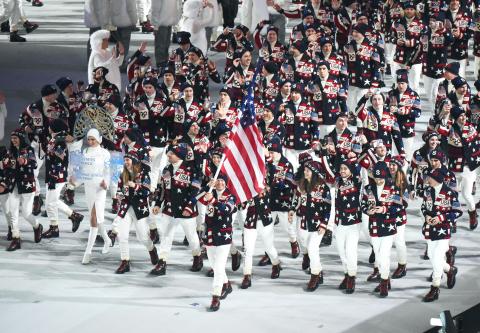
Photo: AFP
Such competition might help explain why the inside of US freeskiing jackets includes a yellow star cut from gear worn to the top of Mount Everest, but snowboarders will wear high-tech corduroy pants and jackets inspired by a quilt found at an antique show.
Fans might be impressed to learn that the aerodynamic suits of the speedskaters were designed with the help of Lockheed Martin. They might be more impressed to know that the similarly clingy uniforms of the luge team were designed by Valiant Entertainment, a comic-book publisher.
The biggest fashion runway was at Friday’s opening ceremony, where the US team marched in heavy cardigans festooned in bold patchwork and iconography, which one fashion pundit compared to wearing Times Square. Afterward, athletes can return to their rooms and relax in specially designed “village apparel,” as if those two words go together.
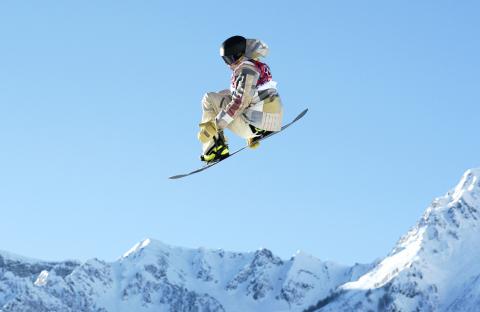
Photo: AFP
The question that viewers might ask, when confronted with the kaleidoscope of styles, is as complex as any of the designs: Why?
Why would companies devote untold hours, effort and money to imagining, creating and making (mostly in the US, after the commotion about Ralph Lauren’s made-in-China collection for the 2012 London Games) mostly small batches of high-tech uniforms with tiny logos that will not be sold to the public?
BRANDING WAR

Photo: AFP
The short answer is a familiar one in business jargon: branding.
“It’s definitely a more broad brand play than it is a moneymaking play,” said Jeff Timmins, senior global brand director for Columbia Sportswear.
Columbia provided freestyle skiing uniforms for Canada, Russia and the US, whose moguls team will wear pants with a “snow camouflage” pattern — white, basically — to disguise motion, a key element of judging.
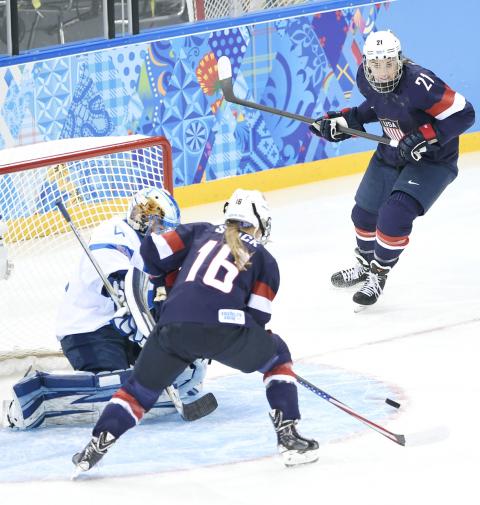
Photo: AFP
Companies and various governing bodies declined to reveal details of their uniform arrangements, but generally, the companies pay for the right to sponsor the Olympic teams and make and supply the uniforms, seeing it as a rare chance to reach a global audience and align themselves — if only temporarily — with some of the world’s top athletes.
“It builds buzz, it’s marketing, it creates fan engagement,” said Peter Zeytoonjian, managing director of consumer products and events for the US Olympic Committee. “It’s not completely different than what any professional sports team does.”
Nike and Ralph Lauren are among those selling some products to the public. That “Times Square” sweater? It was US$598, but Ralph Lauren’s Web site says it is no longer available. The reindeer-themed hat is, for US$95.
Columbia, like several others, uses the Olympics to push technology and fashion in the years to come.
“We wanted to build the best product we’ve ever built,” Timmins said. “We’re using this really as a product design and development opportunity. Some of these skiers are the coolest kids on the mountain; to get their feedback is priceless.”
The only US athletes absolved from becoming runway models for someone else’s idea of patriotic fashion are the figure skaters. They choose their own costumes.
That changes if and when they win a medal, at which point they will don Nike’s medal-stand look, with its “soulful details,” as the company described them, like “Land of the Free” and “Home of the Brave” in the jacket pockets and on the insoles of the shoes.
The design of the uniforms and the deals struck with the manufacturers are left to the national governing bodies for each sport. The US Olympic Committee usually approves the uniforms with little debate, as long as the uniforms conform to the requirements set by the International Olympic Committee.
Those rules, explained in a 33-page book called Guidelines Regarding Authorised Identifications, generally allow only one manufacturer’s logo on each piece of clothing or equipment. On clothes, it must be in specific places (chest or arm) and cannot be more than 20cm2 in size. On equipment, it can be no larger than 6cm2.
Uniform designs must be different from one Winter Olympics to another — no hand-me-downs — but there are no hard rules about palettes. Countries are “encouraged” to use their national colors, although some might think that Germany’s candy-colored striations this year would stretch the guidelines.
Clothing designers, typically, are not conformists, and neither are some of the companies where they work.
“To be honest, the idea of a uniform is a bit counterintuitive to what we’re all about,” said Greg Dacyshyn, chief creative officer of Burton, which dresses the US snowboarding team.
Even with Olympics uniforms, they want to surprise. The goal is buzz among fans, love among clients and jealousy among rivals. With luck, the uniforms will get the positive viral attention of the pants worn by Norway’s curling team — an eye-crossing zigzag pattern of red, white and blue. They were made by Loudmouth, a US company.
TECHNICAL SUPERIORITY
Beyond appearances, companies eagerly tout the technical superiority of their uniforms, from the articulation of elbows to the latest in waterproof zippers. Many features focused on weight, ventilation and aerodynamics, and companies reached deep into the jargon thesaurus to explain them.
The inner details become a game of one-upmanship. Nike said that each US hockey jersey was made from about 17 recycled plastic bottles and that the socks used about five. (Ralph Lauren did not say how many Oregon-based sheep were used for each of its wool cardigans for the opening ceremony.)
Most boldly, perhaps, North Face sewed star-shaped fabric that had been to Mount Everest, with the phrase “Bigger than Me,” into the inside of its jackets for freeskiers in sports like halfpipe, where they will climb a 6.7m wall, not a 8,848m mountain.
Fans might just notice the outside of the clothes. In events where speed is critical, most US teams have gone to black, as if red, white or blue might increase drag. US speedskaters will don black, skintight uniforms designed in a partnership between Under Armour and Lockheed Martin. The uniforms have tiny rubber nubs, because wind-tunnel tests showed that a slight disruption of air is a good thing, not unlike the effect of dimples on a golf ball.
Unlike the snowboarders, whose corduroy pants might make the “vtttt, vtttt” noise as they walk, the speedskaters have anti-friction fabric between their thighs.
The sleek uniforms of US Alpine skiers, by Spyder, are black at the shoulders, fading to ever-lighter blue as they descend to the waist, like pre-dawn over a horizon — specifically, the dawn’s early light over Baltimore Harbor during the War of 1812.
Only at the Olympics, apparently, can Francis Scott Key provide posthumous inspiration to both a ski team and to the insoles of shoes worn on a medal stand.

CAUTIOUS RECOVERY: While the manufacturing sector returned to growth amid the US-China trade truce, firms remain wary as uncertainty clouds the outlook, the CIER said The local manufacturing sector returned to expansion last month, as the official purchasing managers’ index (PMI) rose 2.1 points to 51.0, driven by a temporary easing in US-China trade tensions, the Chung-Hua Institution for Economic Research (CIER, 中華經濟研究院) said yesterday. The PMI gauges the health of the manufacturing industry, with readings above 50 indicating expansion and those below 50 signaling contraction. “Firms are not as pessimistic as they were in April, but they remain far from optimistic,” CIER president Lien Hsien-ming (連賢明) said at a news conference. The full impact of US tariff decisions is unlikely to become clear until later this month

GROWING CONCERN: Some senior Trump administration officials opposed the UAE expansion over fears that another TSMC project could jeopardize its US investment Taiwan Semiconductor Manufacturing Co (TSMC, 台積電) is evaluating building an advanced production facility in the United Arab Emirates (UAE) and has discussed the possibility with officials in US President Donald Trump’s administration, people familiar with the matter said, in a potentially major bet on the Middle East that would only come to fruition with Washington’s approval. The company has had multiple meetings in the past few months with US Special Envoy to the Middle East Steve Witkoff and officials from MGX, an influential investment vehicle overseen by the UAE president’s brother, the people said. The conversations are a continuation of talks that
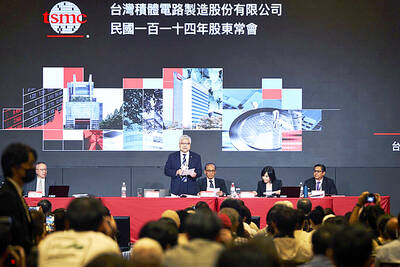
CHIP DUTIES: TSMC said it voiced its concerns to Washington about tariffs, telling the US commerce department that it wants ‘fair treatment’ to protect its competitiveness Taiwan Semiconductor Manufacturing Co (TSMC, 台積電) yesterday reiterated robust business prospects for this year as strong artificial intelligence (AI) chip demand from Nvidia Corp and other customers would absorb the impacts of US tariffs. “The impact of tariffs would be indirect, as the custom tax is the importers’ responsibility, not the exporters,” TSMC chairman and chief executive officer C.C. Wei (魏哲家) said at the chipmaker’s annual shareholders’ meeting in Hsinchu City. TSMC’s business could be affected if people become reluctant to buy electronics due to inflated prices, Wei said. In addition, the chipmaker has voiced its concern to the US Department of Commerce
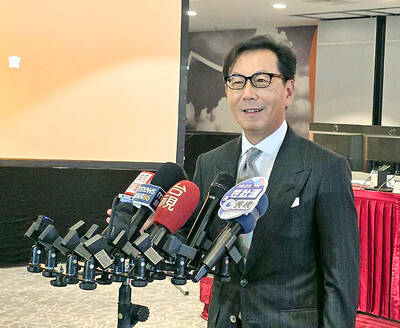
STILL LOADED: Last year’s richest person, Quanta Computer Inc chairman Barry Lam, dropped to second place despite an 8 percent increase in his wealth to US$12.6 billion Staff writer, with CNA Daniel Tsai (蔡明忠) and Richard Tsai (蔡明興), the brothers who run Fubon Group (富邦集團), topped the Forbes list of Taiwan’s 50 richest people this year, released on Wednesday in New York. The magazine said that a stronger New Taiwan dollar pushed the combined wealth of Taiwan’s 50 richest people up 13 percent, from US$174 billion to US$197 billion, with 36 of the people on the list seeing their wealth increase. That came as Taiwan’s economy grew 4.6 percent last year, its fastest pace in three years, driven by the strong performance of the semiconductor industry, the magazine said. The Tsai